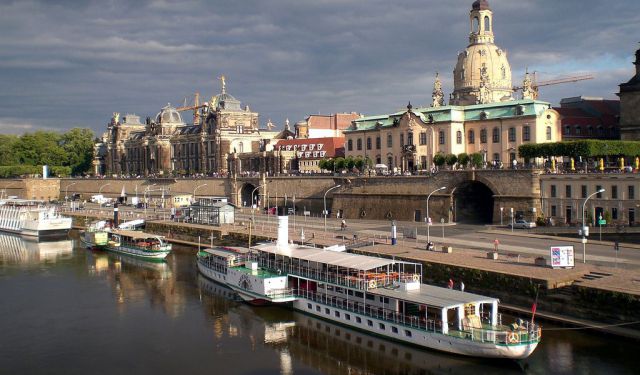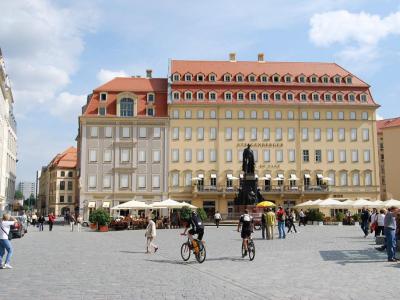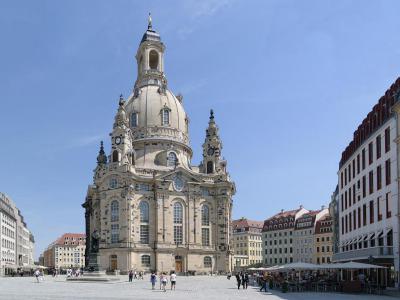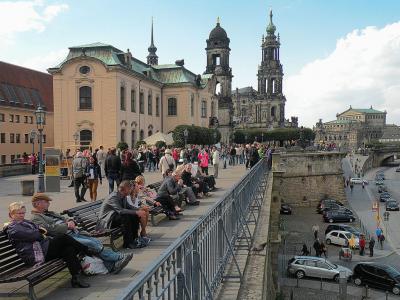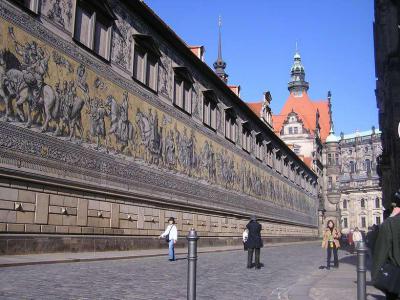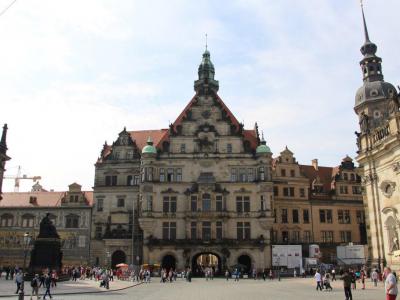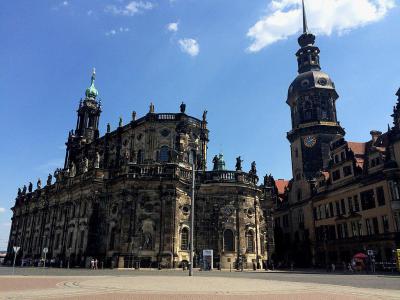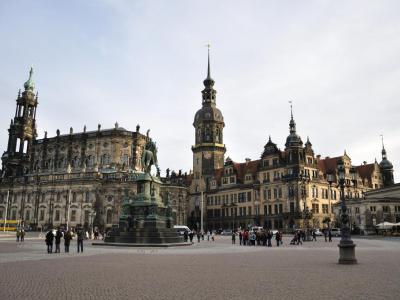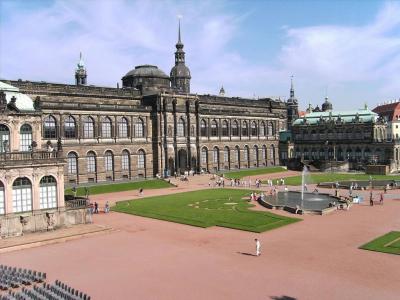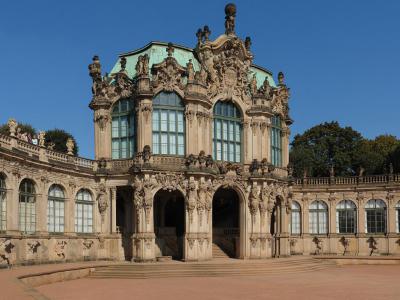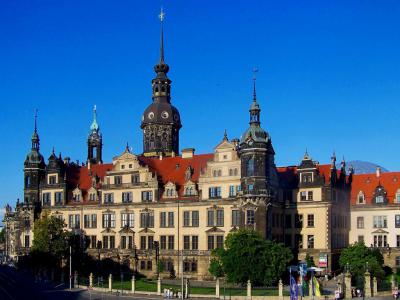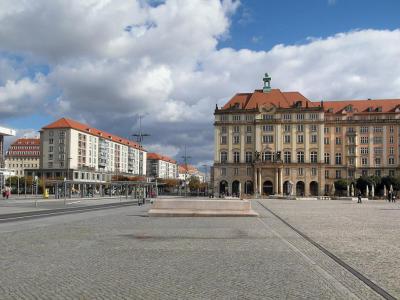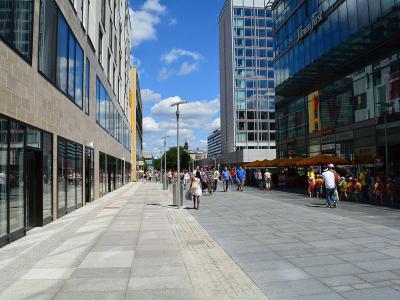Dresden Introduction Walking Tour (Self Guided), Dresden
Dresden was likely settled on the banks of the River Elbe by Neolithic tribes as far back as 7,500 BC. But it also has a long and storied history as the long-time capital of Saxony. The Electors and Kings lived here for centuries, appointing the city with every cultural and artistic treasure.
Its modern form--and its name--comes from early Germanic people, who expanded East to mine the Ore Mountains. The Margraviate of Meissen, a territory of the Holy Roman Empire, was here. Dresden became its capital in 1270, the name deriving from an Old Sorbian word meaning "people of the forest" or "dense forest."
Dresden became the capital of Saxony around 1500. In 1697, King Augustus II the Strong began bringing many of Europe's best artists and musicians to the city, thus beginning the city's emergency as a cultural center.
Many of the baroque landmarks you will see were built during this period, including Church of Our Lady and the Zwinger Royal Palace. Augustus also rebuilt the Dresden Castle. You can get a feel for the history of Saxony and the Kings that ruled it at the Procession of Princes.
The city was bombed heavily by the Allied Forces during World War II. The bombings leveled the inner city.
The Soviet Red Army occupied the city after the war. The overall economic situation of East Germany meant that not much rebuilding occurred. In fact, the city was so heavily damaged from the war that it took until 1977 before the last of the debris clearance teams had finished.
Dresden did, however, become a major industrial center for the East Germany. Thankfully, since reunification in the early 1990s, the city has seen a boom in reconstruction. Many renewals and reconstructions you'll see, such as New Market Square and the restored Church of Our Lady, have occurred since.
Today, the city is a beautiful modern Germany city--full of fascinating history and tastes of Europe. Join us as we stroll the streets and catch the best sights.
Its modern form--and its name--comes from early Germanic people, who expanded East to mine the Ore Mountains. The Margraviate of Meissen, a territory of the Holy Roman Empire, was here. Dresden became its capital in 1270, the name deriving from an Old Sorbian word meaning "people of the forest" or "dense forest."
Dresden became the capital of Saxony around 1500. In 1697, King Augustus II the Strong began bringing many of Europe's best artists and musicians to the city, thus beginning the city's emergency as a cultural center.
Many of the baroque landmarks you will see were built during this period, including Church of Our Lady and the Zwinger Royal Palace. Augustus also rebuilt the Dresden Castle. You can get a feel for the history of Saxony and the Kings that ruled it at the Procession of Princes.
The city was bombed heavily by the Allied Forces during World War II. The bombings leveled the inner city.
The Soviet Red Army occupied the city after the war. The overall economic situation of East Germany meant that not much rebuilding occurred. In fact, the city was so heavily damaged from the war that it took until 1977 before the last of the debris clearance teams had finished.
Dresden did, however, become a major industrial center for the East Germany. Thankfully, since reunification in the early 1990s, the city has seen a boom in reconstruction. Many renewals and reconstructions you'll see, such as New Market Square and the restored Church of Our Lady, have occurred since.
Today, the city is a beautiful modern Germany city--full of fascinating history and tastes of Europe. Join us as we stroll the streets and catch the best sights.
How it works: Download the app "GPSmyCity: Walks in 1K+ Cities" from Apple App Store or Google Play Store to your mobile phone or tablet. The app turns your mobile device into a personal tour guide and its built-in GPS navigation functions guide you from one tour stop to next. The app works offline, so no data plan is needed when traveling abroad.
Dresden Introduction Walking Tour Map
Guide Name: Dresden Introduction Walking Tour
Guide Location: Germany » Dresden (See other walking tours in Dresden)
Guide Type: Self-guided Walking Tour (Sightseeing)
# of Attractions: 12
Tour Duration: 2 Hour(s)
Travel Distance: 2.5 Km or 1.6 Miles
Author: DanaOffice
Sight(s) Featured in This Guide:
Guide Location: Germany » Dresden (See other walking tours in Dresden)
Guide Type: Self-guided Walking Tour (Sightseeing)
# of Attractions: 12
Tour Duration: 2 Hour(s)
Travel Distance: 2.5 Km or 1.6 Miles
Author: DanaOffice
Sight(s) Featured in This Guide:
- Neumarkt (New Market Square)
- Frauenkirche (Church of Our Lady)
- Brühl's Terrace
- Fürstenzug (Procession of Princes)
- Georgentor (George Gate)
- Katholische Hofkirche (Catholic Church)
- Theaterplatz (Theatre Square)
- Old Masters Picture Gallery
- Zwinger (Palatial Complex)
- Dresden Castle
- Altmarkt (Old Market Square)
- Prager Straße (Prague Street)
1) Neumarkt (New Market Square)
New Market Square (Neumarkt), located in the heart of Dresden, is a historically significant square that has experienced extensive transformations over the centuries. Originally established on a slight elevation above the flood-prone Elbe River, this area began as a small village surrounding the Frauenkirche. It became part of the fortified city in 1530 when Dresden expanded its walls, distinguishing itself from the Altmarkt, which was centered around the Kreuzkirche.
The New Market flourished during the reign of August II the Strong, a period marked by the adoption of the Baroque architectural style. This era saw the construction of the current Frauenkirche and numerous surrounding structures. The square further evolved in the 18th century following damage from the Seven Years' War, with many buildings being restored or reconstructed in the Rococo/Late Baroque style.
By the 19th and early 20th centuries, the New Market Square underwent few changes, with significant renovations such as the completion of the Johanneum in 1873 and the construction of the Albertinum and the Academy of Fine Arts by the late 1800s. However, the area was nearly obliterated during the Allied bombing in World War II.
Following the war, Dresden fell under Soviet control and later became part of the German Democratic Republic. During this time, parts of the square were reconstructed in a Socialist Realist style, and some historic buildings were partially rebuilt. However, many plots remained undeveloped.
The Neumarkt is now divided into eight "quarters," each considered a separate project in terms of reconstruction. The approach is to rebuild buildings either entirely as they were or at least to replicate the original facades. As of 2020, most quarters are complete, with only Quarter III and Quarter VII still under construction, signaling a near-complete revival of this storied square.
The New Market flourished during the reign of August II the Strong, a period marked by the adoption of the Baroque architectural style. This era saw the construction of the current Frauenkirche and numerous surrounding structures. The square further evolved in the 18th century following damage from the Seven Years' War, with many buildings being restored or reconstructed in the Rococo/Late Baroque style.
By the 19th and early 20th centuries, the New Market Square underwent few changes, with significant renovations such as the completion of the Johanneum in 1873 and the construction of the Albertinum and the Academy of Fine Arts by the late 1800s. However, the area was nearly obliterated during the Allied bombing in World War II.
Following the war, Dresden fell under Soviet control and later became part of the German Democratic Republic. During this time, parts of the square were reconstructed in a Socialist Realist style, and some historic buildings were partially rebuilt. However, many plots remained undeveloped.
The Neumarkt is now divided into eight "quarters," each considered a separate project in terms of reconstruction. The approach is to rebuild buildings either entirely as they were or at least to replicate the original facades. As of 2020, most quarters are complete, with only Quarter III and Quarter VII still under construction, signaling a near-complete revival of this storied square.
2) Frauenkirche (Church of Our Lady) (must see)
The current Church of Our Lady is a Lutheran church built between 1726 and 1743. It features Baroque architecture and has one of Europe's largest domes.
The first Church of Our Lady was a Catholic church built in the 11th century. It became a Protestant church during the Reformation. The original church was torn down and replaced by the new Luthern church.
In 1736, Gottfried Silbermann built an exceptional 43-stop organ for the church. Johann Sebastian Bach played a recital on the organ on December 1, 1736.
The church's iconic dome is 96 meters (315 feet) tall. The dome is known as Stone Bell ("die Steinerne Glocke" in German). The dome is often compared to Michelangelo's Saint Peter's Basilica dome. Stone Bell weighed 12,000 tons and was originally held up by eight supports.
In 1945, Allied forces bombed Dresden. The church survived two days of attacks before collapsing. While most of the church was destroyed, the original altar and chancel were salvaged.
Residents salvaged and numbered stone fragments, hoping to use them in a future reconstruction. In 1994, Gunter Blobel won the Nobel Prize for medicine and donated his prize money to restore the Church of Our Lady. In addition, England's Prince Edward supported the Dresden Trust which contributed funds for the reconstruction project.
Rebuilding the Church of Our Lady cost 180 million Euros. The rebuilding effort began in 1992 and was completed in 2005. The church was rebuilt using the original plans from the 1720s and salvaged materials. About 3,800 original stones were used in the reconstruction. One can see the original stones in the building as they appear darker due to age and fire damage.
Rebuilding the church was a community-wide effort. Builders relied on photographs and memories to reconstruct the details. For example, old wedding albums helped builders reconstruct the church's carved oak doors.
A new orb and cross were forged and placed on top of the dome. The original damaged cross stands inside by the church's altar. The original organ was replaced with a 68-stop organ.
The rebuilt Church of Our Lady is a popular attraction. US President Barack Obama visited the church in 2009.
The first Church of Our Lady was a Catholic church built in the 11th century. It became a Protestant church during the Reformation. The original church was torn down and replaced by the new Luthern church.
In 1736, Gottfried Silbermann built an exceptional 43-stop organ for the church. Johann Sebastian Bach played a recital on the organ on December 1, 1736.
The church's iconic dome is 96 meters (315 feet) tall. The dome is known as Stone Bell ("die Steinerne Glocke" in German). The dome is often compared to Michelangelo's Saint Peter's Basilica dome. Stone Bell weighed 12,000 tons and was originally held up by eight supports.
In 1945, Allied forces bombed Dresden. The church survived two days of attacks before collapsing. While most of the church was destroyed, the original altar and chancel were salvaged.
Residents salvaged and numbered stone fragments, hoping to use them in a future reconstruction. In 1994, Gunter Blobel won the Nobel Prize for medicine and donated his prize money to restore the Church of Our Lady. In addition, England's Prince Edward supported the Dresden Trust which contributed funds for the reconstruction project.
Rebuilding the Church of Our Lady cost 180 million Euros. The rebuilding effort began in 1992 and was completed in 2005. The church was rebuilt using the original plans from the 1720s and salvaged materials. About 3,800 original stones were used in the reconstruction. One can see the original stones in the building as they appear darker due to age and fire damage.
Rebuilding the church was a community-wide effort. Builders relied on photographs and memories to reconstruct the details. For example, old wedding albums helped builders reconstruct the church's carved oak doors.
A new orb and cross were forged and placed on top of the dome. The original damaged cross stands inside by the church's altar. The original organ was replaced with a 68-stop organ.
The rebuilt Church of Our Lady is a popular attraction. US President Barack Obama visited the church in 2009.
3) Brühl's Terrace (must see)
Brühl's Terrace is often called "The Balcony of Europe." This high terrace overlooks the river Elbe and is a popular place to walk, admire the architecture, and enjoy an outdoor cafe.
Brühl's Terrace was built on the city's fortifications that were rebuilt in 1547. The terrace is named after Count Heinrich von Brühl, who had a Dresden city palace. In 1747 the Saxon elector gave Brühl the terrace to thank him for introducing a betterment tax.
When Russian troops occupied Dresden in 1814, Prince Nikolai Grigorjevich Repnin-Wolkonski ordered the terrace to open to the public. At that time, architect Gottlob Friedrich Thormeyer built stairs at the terrace's western end to be accessible from Castle Square and Augustus Bridge.
The terrace's original buildings were destroyed during World War II bombing attacks. The terrace has since been rebuilt and is one of Dresden's main attractions.
The terrace features a monument for Johann Friedrich Böttger, an alchemist who invented European porcelain. Visitors can see a fingerprint near the monument in one of the garden's guard rails. This fingerprint is said to have been left by legendary Augustus the Strong.
Today's terrace buildings include Saxony's Supreme Court, the Sächsisches Ständehaus, the Academy of Fine Arts, and the Albertinum.
As you stroll the terrace, you may find many artists painting and selling artworks.
Brühl's Terrace was built on the city's fortifications that were rebuilt in 1547. The terrace is named after Count Heinrich von Brühl, who had a Dresden city palace. In 1747 the Saxon elector gave Brühl the terrace to thank him for introducing a betterment tax.
When Russian troops occupied Dresden in 1814, Prince Nikolai Grigorjevich Repnin-Wolkonski ordered the terrace to open to the public. At that time, architect Gottlob Friedrich Thormeyer built stairs at the terrace's western end to be accessible from Castle Square and Augustus Bridge.
The terrace's original buildings were destroyed during World War II bombing attacks. The terrace has since been rebuilt and is one of Dresden's main attractions.
The terrace features a monument for Johann Friedrich Böttger, an alchemist who invented European porcelain. Visitors can see a fingerprint near the monument in one of the garden's guard rails. This fingerprint is said to have been left by legendary Augustus the Strong.
Today's terrace buildings include Saxony's Supreme Court, the Sächsisches Ständehaus, the Academy of Fine Arts, and the Albertinum.
As you stroll the terrace, you may find many artists painting and selling artworks.
4) Fürstenzug (Procession of Princes) (must see)
The Procession of Princes is an impressive mural that shows Saxony's rulers. The painting was commissioned to celebrate the Wettin Dynasty's 800th anniversary in 1889.
Wilhelm Walther painted the original painting. It took Walther five years to complete the painting, which was finished in 1876. When the artwork began to fade, a preservation plan was implemented. Between 1904 and 1907, the painting was replaced by 23,000 porcelain tiles to make the artwork weatherproof.
The artwork is 102 meters (335 feet) long and is the world's largest porcelain artwork. The mural shows the portraits of the House of Wettin's 35 margraves, electors, dukes, and kings from 1127 to 1904. The rulers are shown on horses with their names written underneath them.
The first ruler in the procession mural is 12th-century ruler Conrad, Margrave of Meissen. The last king of Saxony, Frederick Augustus III, who ruled from 1904 to 1918, is not shown.
The mural also shows 59 farmers, craftsmen, scientists, artists, and children. A girl in the children's group is the only female shown in the procession. The last person shown in the procession is the mural's original creator, Wilhelm Walther.
The Procession of Princes was designed to look like a giant tapestry. The top edge features depictions of 38 individual hanging knobs to make the mural look like a tapestry hung on a wall. The mural also features ornamental frames with plants, butterflies, and birds.
Wilhelm Walther painted the original painting. It took Walther five years to complete the painting, which was finished in 1876. When the artwork began to fade, a preservation plan was implemented. Between 1904 and 1907, the painting was replaced by 23,000 porcelain tiles to make the artwork weatherproof.
The artwork is 102 meters (335 feet) long and is the world's largest porcelain artwork. The mural shows the portraits of the House of Wettin's 35 margraves, electors, dukes, and kings from 1127 to 1904. The rulers are shown on horses with their names written underneath them.
The first ruler in the procession mural is 12th-century ruler Conrad, Margrave of Meissen. The last king of Saxony, Frederick Augustus III, who ruled from 1904 to 1918, is not shown.
The mural also shows 59 farmers, craftsmen, scientists, artists, and children. A girl in the children's group is the only female shown in the procession. The last person shown in the procession is the mural's original creator, Wilhelm Walther.
The Procession of Princes was designed to look like a giant tapestry. The top edge features depictions of 38 individual hanging knobs to make the mural look like a tapestry hung on a wall. The mural also features ornamental frames with plants, butterflies, and birds.
5) Georgentor (George Gate)
The George Gate is Dresden's first Renaissance building. George the Bearded commissioned the gate which was built between 1530 and 1535. The George Gate replaced a city gate that provided the original exit from Dresden to the Elbe bridge.
The building's facade features decorate figures with a religious theme. In addition, George the Bearded's motto is inscribed on the facade--"through envy of the devil came death into the world" (in Germany ""Per Invidiam Diaboli Mors Intravit In Orbem").
In 1701, a fire destroyed Dresden castle, and George Gate was renovated to house royal apartments. In 1833, an additional level was added, and in 1868 a ballroom was added.
The facade was redesigned to reflect the Neo-Renaissance style in 1901. Sculptor Christian Behren created an imposing equestrian statue of George the Bearded in George Gate's gable.
Saxony's last king, Friedrich August III, lived in George Gate until 1918. George Gate was destroyed by World War II bombs in 1945 and reconstructed during the 1960s.
George Gate houses several exhibitions. Visitors can see the Coin Cabinet with a collection of ancient medals and coins. In addition, George Gate houses an artwork exhibition.
The building's facade features decorate figures with a religious theme. In addition, George the Bearded's motto is inscribed on the facade--"through envy of the devil came death into the world" (in Germany ""Per Invidiam Diaboli Mors Intravit In Orbem").
In 1701, a fire destroyed Dresden castle, and George Gate was renovated to house royal apartments. In 1833, an additional level was added, and in 1868 a ballroom was added.
The facade was redesigned to reflect the Neo-Renaissance style in 1901. Sculptor Christian Behren created an imposing equestrian statue of George the Bearded in George Gate's gable.
Saxony's last king, Friedrich August III, lived in George Gate until 1918. George Gate was destroyed by World War II bombs in 1945 and reconstructed during the 1960s.
George Gate houses several exhibitions. Visitors can see the Coin Cabinet with a collection of ancient medals and coins. In addition, George Gate houses an artwork exhibition.
6) Katholische Hofkirche (Catholic Church) (must see)
Dresden Cathedral is Dresden's most important Catholic church. Architect Gaetano Chiavari designed the Baroque church, which was completed in 1751. It was commissioned by Augustus II, Elector of Saxony and King of Poland. Dresden Cathedral was built at the same time as the Lutheran Church of Our Lady.
Dresden's population was Protestant, but its rulers were Catholic. Augustus II built the church for his own use and connected it to Dresden Castle with a decorative walkway. It was originally known as the Court Church of the Most Holy Trinity. It became a cathedral in 1964.
The cathedral's balustrades feature 78 statues of saints. A procession ambulatory was integrated into the interior because outdoor Catholic worship was forbidden.
The baptismal font features a gilded metal lid and was designed in 1721. In addition, the cathedral has an organ built by famed organist Gottfried Silbermann.
Many of Saxon's rulers are buried in the cathedral's crypts. The Founder's Crypt holds the remains of Polish King Augustus III. King Augustus the Strong is buried here, as is the last King of Saxony.
Dresden Cathedral was damaged during World War II bombing raids and was restored in 1962.
Dresden's population was Protestant, but its rulers were Catholic. Augustus II built the church for his own use and connected it to Dresden Castle with a decorative walkway. It was originally known as the Court Church of the Most Holy Trinity. It became a cathedral in 1964.
The cathedral's balustrades feature 78 statues of saints. A procession ambulatory was integrated into the interior because outdoor Catholic worship was forbidden.
The baptismal font features a gilded metal lid and was designed in 1721. In addition, the cathedral has an organ built by famed organist Gottfried Silbermann.
Many of Saxon's rulers are buried in the cathedral's crypts. The Founder's Crypt holds the remains of Polish King Augustus III. King Augustus the Strong is buried here, as is the last King of Saxony.
Dresden Cathedral was damaged during World War II bombing raids and was restored in 1962.
7) Theaterplatz (Theatre Square)
The Theatre Square (Theaterplatz) in Dresden is a significant and historic square located west of the city's inner old town. The square is famously positioned in front of the Dresden Semperoper (Semper Opera House), the esteemed former court theater from which it derives its name. Theatre Square stretches between the Post Office (Postplatz) and the Augustus Bridge, directly bordering the elevated banks of the Elbe River. This prime location offers a sweeping view across the Elbe and into the lush expanse of the Dresdner Heath, especially notable from the approach to the Augustus Bridge.
Architecturally, the Theatre Square is surrounded by significant buildings, each with its historical and cultural importance. To the north, the Italian Village, designed by Hans Erlwein, marks one of the newer additions to the square. From here, visitors can also view the Erlwein Storage (Erlweinspeicher), a noted technical structure. The southeast side of the square features the only fully baroque building in the area, the Dresden Cathedral, separated from the expansive Dresden Castle by a small alley. The castle itself has undergone extensive expansions and redesigns over time.
The south-southwest side of the square showcases the Semper Gallery, adorned with a Neorenaissance façade, while the northwest side is dominated by the most celebrated structure in the square, the Semper Opera House. This opera house, designed by Gottfried Semper, stands as the third iteration of the building at this location, cementing its historical and cultural significance.
Architecturally, the Theatre Square is surrounded by significant buildings, each with its historical and cultural importance. To the north, the Italian Village, designed by Hans Erlwein, marks one of the newer additions to the square. From here, visitors can also view the Erlwein Storage (Erlweinspeicher), a noted technical structure. The southeast side of the square features the only fully baroque building in the area, the Dresden Cathedral, separated from the expansive Dresden Castle by a small alley. The castle itself has undergone extensive expansions and redesigns over time.
The south-southwest side of the square showcases the Semper Gallery, adorned with a Neorenaissance façade, while the northwest side is dominated by the most celebrated structure in the square, the Semper Opera House. This opera house, designed by Gottfried Semper, stands as the third iteration of the building at this location, cementing its historical and cultural significance.
8) Old Masters Picture Gallery (must see)
Augustus, Elector of Saxony, first founded an Art Chamber in 1560. During the 18th century, Augustus the Strong and his heir Frederick Augustus II made significant additions. In 1754, Electors added Raphael’s Sistine Madonna to the collection. The growing collection moved to the Semper Gallery in 1855.
The paintings were stored during World War II and then confiscated by the Red Army. The surviving paintings were returned to Dresden in 1955, and the Old Masters Gallery re-opened in 1960.
The Old Masters Picture Gallery underwent a 50 million dollar renovation completed in 2020. Classic paintings are now displayed amongst the museum's impressive sculpture collection.
Seven hundred paintings were rehung among 420 sculptures. Visitors can see priceless paintings by Rembrandt, Titian, and Raphael. Popular artworks include Vermeer’s Girl Reading a Letter at an Open Window, Rembrandt’s Ganymede, and Titian’s Zinsgroschen.
Artworks are now hung on vibrant walls and grouped by region and time period. For example, Italian works are hung on crimson walls, while French and Spanish works are featured on blue walls.
The paintings were stored during World War II and then confiscated by the Red Army. The surviving paintings were returned to Dresden in 1955, and the Old Masters Gallery re-opened in 1960.
The Old Masters Picture Gallery underwent a 50 million dollar renovation completed in 2020. Classic paintings are now displayed amongst the museum's impressive sculpture collection.
Seven hundred paintings were rehung among 420 sculptures. Visitors can see priceless paintings by Rembrandt, Titian, and Raphael. Popular artworks include Vermeer’s Girl Reading a Letter at an Open Window, Rembrandt’s Ganymede, and Titian’s Zinsgroschen.
Artworks are now hung on vibrant walls and grouped by region and time period. For example, Italian works are hung on crimson walls, while French and Spanish works are featured on blue walls.
9) Zwinger (Palatial Complex) (must see)
The Zwinger is one of Germany's most impressive Baroque buildings. August the Strong commissioned the complex after visiting Louis XIV's Versailles Palace. The palace was designed as an orangery, garden, and festival area. Architect Matthäus Daniel Pöppelmann designed the palace, which was built between 1710 and 1728.
The Zwinger name refers to an area between defensive walls. In the 15th century, Dresden had a Zwinger garden in between the city walls that supplied the royal court with fresh produce. The present-day Zwinger is in a different location, but the new palace kept the old garden's name.
The Zwinger was primarily a royal entertainment venue and features ornate portals and extravagant fountains. Sculptor Balthasar Permoser’s Nymph's Bath is one fine example of the Zwinger's fabulous Baroque fountains.
Other attractions include an Atlas sculpture on top of the western pavilion. In addition, a carillon with 40 porcelain bells plays every 15 minutes. The chimes change every season and feature melodies by Vivaldi, Mozart, Bach, Wagner, and Weber.
The Zwinger hosted a royal wedding in 1719 when Augustus the Strong’s son Frederick August married Maria Josepha, the daughter of Habsburg emperor Joseph I.
The courtyard garden and pond were added in the 1820s. The gallery wing that now houses the Old Masters Gallery was built in 1855.
The Zwinger was heavily damaged during World War II bombs. It was reconstructed during the 1950s. The Zwinger houses three museums, including the Old Masters Gallery, the Porcelain Collection, and the Mathematical and Physical Instruments collection. The Zwinger and its gardens are open to the public.
The Zwinger name refers to an area between defensive walls. In the 15th century, Dresden had a Zwinger garden in between the city walls that supplied the royal court with fresh produce. The present-day Zwinger is in a different location, but the new palace kept the old garden's name.
The Zwinger was primarily a royal entertainment venue and features ornate portals and extravagant fountains. Sculptor Balthasar Permoser’s Nymph's Bath is one fine example of the Zwinger's fabulous Baroque fountains.
Other attractions include an Atlas sculpture on top of the western pavilion. In addition, a carillon with 40 porcelain bells plays every 15 minutes. The chimes change every season and feature melodies by Vivaldi, Mozart, Bach, Wagner, and Weber.
The Zwinger hosted a royal wedding in 1719 when Augustus the Strong’s son Frederick August married Maria Josepha, the daughter of Habsburg emperor Joseph I.
The courtyard garden and pond were added in the 1820s. The gallery wing that now houses the Old Masters Gallery was built in 1855.
The Zwinger was heavily damaged during World War II bombs. It was reconstructed during the 1950s. The Zwinger houses three museums, including the Old Masters Gallery, the Porcelain Collection, and the Mathematical and Physical Instruments collection. The Zwinger and its gardens are open to the public.
10) Dresden Castle (must see)
Dresden Castle is one of Dresden's oldest buildings. It served as a royal residence for almost 400 years and housed Saxony electors and Saxony and Polish kings. The castle features different architectural styles, such as Baroque and Neo-renaissance.
The castle was originally built in the 13th century as a Romanesque keep. The keep was extended in the 15th century and again in the 16th century. A fire damaged the castle in 1701, and Augustus the Strong rebuilt the castle and added the western wing collection rooms. The castle was rebuilt in the ornate Baroque style.
The House of Wettin celebrated its 800th anniversary with further renovations and additions between 1889 and 1901. The Stall Courtyard was painted with the famous "Procession of Princes ." In 1914, additional renovations modernized the castle with heating and electric lights.
World War II bombs heavily damaged Dresden Castle. Restoration work started in the 1960s and continues today.
The castle is now home to a collection of museums that are housed in Augustus the Strong's collection rooms. The museums include the Historic Green Vault, the New Green Vault, the Numismatic Cabinet, the Collection of Prints, Drawings, and Photographs, and the Dresden Armory. Guests can also visit an art library with 260,000 titles related to art history.
The Hausmann Tower offers a beautiful view of Dresden's Old Town. In addition, the English Stairway was reconstructed using the original Baroque design.
The castle was originally built in the 13th century as a Romanesque keep. The keep was extended in the 15th century and again in the 16th century. A fire damaged the castle in 1701, and Augustus the Strong rebuilt the castle and added the western wing collection rooms. The castle was rebuilt in the ornate Baroque style.
The House of Wettin celebrated its 800th anniversary with further renovations and additions between 1889 and 1901. The Stall Courtyard was painted with the famous "Procession of Princes ." In 1914, additional renovations modernized the castle with heating and electric lights.
World War II bombs heavily damaged Dresden Castle. Restoration work started in the 1960s and continues today.
The castle is now home to a collection of museums that are housed in Augustus the Strong's collection rooms. The museums include the Historic Green Vault, the New Green Vault, the Numismatic Cabinet, the Collection of Prints, Drawings, and Photographs, and the Dresden Armory. Guests can also visit an art library with 260,000 titles related to art history.
The Hausmann Tower offers a beautiful view of Dresden's Old Town. In addition, the English Stairway was reconstructed using the original Baroque design.
11) Altmarkt (Old Market Square)
Old Market Square has been a vital part of Dresden since the 13th century. Old Market Square has hosted markets, games, and festivals throughout its history.
World War II bombs destroyed the historical square. It has since been reconstructed according to historical plans. The Dresden Palace of Culture was completed in 1969 and features modern architecture with a dynamic symmetrical trapezoid roof. The rest of the buildings were reconstructed to continue to Baroque architectural heritage.
Landmark buildings include the Old Market House (Haus Altmarkt) and the 92-meter-high (302-foot) Holly Cross Church (Kreuzkirche).
Visitors will find several interesting plaques in the square. A commemorative plaque dedicated to German poet and writer Ludwig Tieck is displayed on Tieck's former home at the corner of Old Market Square and Kreuz Street (Kreuzstrasse). Tieck was one of the founding fathers of the Romantic movement in the late 18th and early 19th centuries
Visitors will also find a bronze plaque commemorating the 1849 May Uprising in the northwest corner. A plaque commemorates the market's post-war foundation stone can be found on the square's west side. Finally, a small embedded memorial featuring a two-line inscription is dedicated to the people who died in Dresden during World War II.
Old Market Square hosts the annual Dresden Autumn Festival and the Dresden Christmas Market. Dresden's Christmas Market is one of the oldest in the world and has been held since 1434. The square hosts a huge Christmas tree and a 14-meter high (46-foot) pyramid.
World War II bombs destroyed the historical square. It has since been reconstructed according to historical plans. The Dresden Palace of Culture was completed in 1969 and features modern architecture with a dynamic symmetrical trapezoid roof. The rest of the buildings were reconstructed to continue to Baroque architectural heritage.
Landmark buildings include the Old Market House (Haus Altmarkt) and the 92-meter-high (302-foot) Holly Cross Church (Kreuzkirche).
Visitors will find several interesting plaques in the square. A commemorative plaque dedicated to German poet and writer Ludwig Tieck is displayed on Tieck's former home at the corner of Old Market Square and Kreuz Street (Kreuzstrasse). Tieck was one of the founding fathers of the Romantic movement in the late 18th and early 19th centuries
Visitors will also find a bronze plaque commemorating the 1849 May Uprising in the northwest corner. A plaque commemorates the market's post-war foundation stone can be found on the square's west side. Finally, a small embedded memorial featuring a two-line inscription is dedicated to the people who died in Dresden during World War II.
Old Market Square hosts the annual Dresden Autumn Festival and the Dresden Christmas Market. Dresden's Christmas Market is one of the oldest in the world and has been held since 1434. The square hosts a huge Christmas tree and a 14-meter high (46-foot) pyramid.
12) Prager Straße (Prague Street)
Prague Street was built between 1851 and 1853 as a connecting street between a new train station and the city center. The street became a popular shopping and entertainment street. The street was destroyed during World War II and later rebuilt as a pedestrian-only zone. Instead of following the original plans, the street was rebuilt as a wide, modern street.
Prague Street features residential apartment buildings, hotels, and shops. Visitors will find various gardens, fountains, and sculptures as they walk.
The Centrum-Galerie features a remarkable aluminum facade with a unique honeycomb design that echoes the original Centrum department store's design. The UFA Crystal Palace was built in 1998 and features a dramatic design using glass and concrete.
Today, Prague Street is an attractive shopping street. Visitors will find popular department stores and over 100 shops, cafes, and restaurants.
Prague Street features residential apartment buildings, hotels, and shops. Visitors will find various gardens, fountains, and sculptures as they walk.
The Centrum-Galerie features a remarkable aluminum facade with a unique honeycomb design that echoes the original Centrum department store's design. The UFA Crystal Palace was built in 1998 and features a dramatic design using glass and concrete.
Today, Prague Street is an attractive shopping street. Visitors will find popular department stores and over 100 shops, cafes, and restaurants.
Walking Tours in Dresden, Germany
Create Your Own Walk in Dresden
Creating your own self-guided walk in Dresden is easy and fun. Choose the city attractions that you want to see and a walk route map will be created just for you. You can even set your hotel as the start point of the walk.
Dresden's Architectural Jewels
If there is one thing Dresden is particularly famous for, it is the magnificent architecture. Although known primarily for its Baroque buildings, the city has several other architectural styles present too, such as Renaissance, Historicism, Modernism and Post-modernism.
Much of downtown Dresden was destroyed in February 1945 by Allied bombing, which in turn prompted the rebuilding of the... view more
Tour Duration: 1 Hour(s)
Travel Distance: 1.9 Km or 1.2 Miles
Much of downtown Dresden was destroyed in February 1945 by Allied bombing, which in turn prompted the rebuilding of the... view more
Tour Duration: 1 Hour(s)
Travel Distance: 1.9 Km or 1.2 Miles
Dresden New Town Walk
The Neustadt (New Town) of Dresden is a central district located on the north bank of the Elbe. Despite the name, this part of the city is not at all new and has been inhabited for as long as the Old Town on the opposite side of the river. Its “novelty” derives from "Neue Königliche Stadt" (New Royal Town), which is the title given to the area, formerly the district of Altendresden,... view more
Tour Duration: 1 Hour(s)
Travel Distance: 2.2 Km or 1.4 Miles
Tour Duration: 1 Hour(s)
Travel Distance: 2.2 Km or 1.4 Miles
The Most Popular Cities
/ view all
